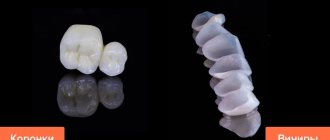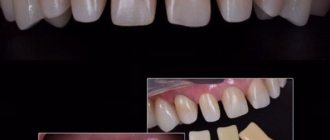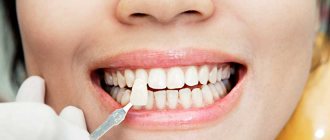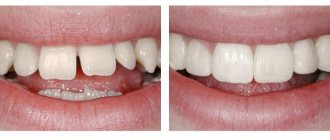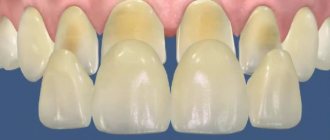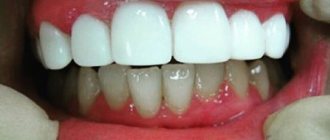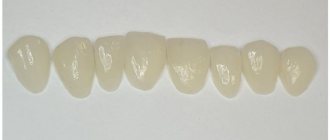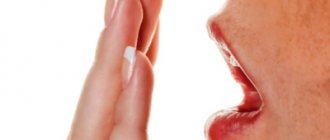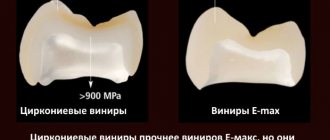Is it possible to get veneers if there are no teeth?
Last purchase: 01/21/2019 - 4 minutes ago just now
9 visitors are studying our product at once
Country of origin: USA
Packing: plastic packaging
Weight: 1 set
Contains environmentally friendly materials Not a medicinal product
The product is certified
Delivery to the city: from 70 rubles, the operator will specify
Payment: by card or cash upon delivery
Video:
If the tooth is alive, it is enough to cover it with a veneer.
If dead, a full crown is required.
How many veneers do you need for a smile? Depending on the degree of openness, to create a beautiful smile, you need to wear from 6 to 10 veneers on your front teeth. How long do veneers last and when will they need replacement? Even strong natural enamel rarely lasts as long as veneers last.
Considering how long veneers last on the teeth, we can say that these are veneers for life. Do veneers darken? Only cheap composite veneers darken.
Veneers for healthy teeth
The appearance of ceramic veneers does not change in any way. For 25 years or more, they do not darken or turn yellow, they clean well, do not retain plaque and do not form tartar.
This compares favorably with composite veneers and even with tooth enamel. How to care for veneers Caring for veneers is even easier than natural enamel. There are, of course, some taboos: But this also applies to natural teeth! Avoiding blows is also a very clear recommendation: Therefore, for extreme sports, we will make you a special mouthguard.
And don’t forget to visit the dentist once every six months for a preventive examination. Then the life of your veneers will be long and serenely happy. Emelyanov Sergey Nikolaevich Questions from our patients Is it true that veneers spoil teeth? On the one hand, to install a veneer, you have to grind off part of the enamel.
But on the other hand, no one puts veneers on teeth with perfect enamel! After installing ceramic veneers, teeth become more beautiful, more durable and stronger, so the benefits from them are clearly greater than the harm.
- After this, the structures are finally secured.
- Veneers are in great demand in dental practice today.
- You can receive the parcel after delivery at the nearest post office. Is it possible to get veneers if you have no teeth?
There are only metal-ceramic crowns. Veneers are made from metal-free ceramics. Is it possible to remove unsuccessful veneers? It is possible, first of all, composite ones, and we quite often have to do this.
However, if you have already decided to get veneers, come straight to the place where they will be installed for you with high quality, for a long time and without the need for replacement.
Veneer for a pulpless tooth – yes or no?
Smooth, beautiful, healthy teeth, without defects, not affected by caries... for many today this remains only a cherished dream and, unfortunately, an unrealizable desire. The worst thing is when bad teeth are located in front, along the smile line - dark enamel, carious holes, yellowed fillings, and a tooth canal that has changed due to nerve removal greatly spoil a person’s appearance. Modern cosmetic dentistry has available means to cope with many problems of the aesthetics of the front teeth, but the question is: is it possible to install a veneer on a pulpless tooth ?
In some dental clinics, the patient will answer this question in the negative, as in the case of multiple indicators for the installation of a decorative dental plate. But you should not despair, since this does not always happen, and it is still possible to restore the front teeth that have changed as a result of depulpation using veneers.
Find out more about the benefits of veneers and lumineers
Tooth veneer
Some individual characteristics may appear, such as tooth sensitivity to hot and cold. But they occur extremely rarely and go away within a few days. However, in any unclear case, you should see your doctor.
Should I get veneers during pregnancy? The main obstacle for pregnant women to install veneers is the administration of anesthesia. Since the installation of veneers is a planned event, it makes sense to wait until the end of feeding and calmly carry out the plan.
We work from Monday to Friday from 7-00 to 21-00. Perfect teeth are very rare. Most people need their teeth straightened. Contraindications for installation There are a number of cases in which it is not recommended to install veneers. If the jaws are not positioned correctly, problems usually arise not only with the dentures, but also with the jaw joints.
Bruxism is the grinding of teeth at night. Lack of desire to take care of oral health and hygiene. The installed veneers require care; there are restrictions on the consumption of certain types of food.
Do teeth deteriorate under veneers?
You won’t be able to get veneers and forget about them. The fact is that to install the structure it is necessary to grind off the enamel. In a few years the procedure will have to be repeated. But under the veneers themselves, the teeth do not deteriorate; on the contrary, they are protected from the influence of external factors.
Attention! It is necessary to discuss all the details with specialists in advance, since removing the plates on your own is impossible, and reinstallation in a hospital setting will disturb the condition of the teeth, and also requires money and time.
Who needs veneers and why?
Finally, the veneers are attached to the teeth. Advantages Modern dental methods make it possible to improve the appearance of teeth without lengthy, unpleasant procedures.
Veneers can be installed in 2-3 visits to the doctor. Their important advantages are: If you follow the recommendations, high-quality mini-prostheses will last up to 20 years. If an indirect veneer was made on this tooth, the entire outer surface would have to be prepared by 1.5-2 mm. If it were a crown, then the tooth would have to be filed on all sides: In this photo, the coated metal crowns have been removed, and veneers have been made on the teeth.
How to wear veneers if there are no back teeth
There are several options for solving the problem of missing posterior chewing teeth. The dentist chooses the method of restoring the dentition after a full examination of the remaining healthy teeth and establishing the possibility of installing bridges or crowns.
Options for restoring missing back teeth:
- Basal implantation - makes it possible to install from 2 to 4 implants, after which on the 3-4th day the dentist has the opportunity to install permanent dentures from a mixture of metal and plastic. Veneers are not installed in this case.
- Nylon removable dentures are special designs created from soft and flexible nylon material. This is temporary prosthetics and does not require the installation of veneers.
- Plate removable dentures are made from plastic materials and are significantly cheaper than nylon structures. The service life of such structures is up to 5 years; installation of veneers is impossible.
Crowns are installed on dead pulpless teeth; before this, the dentist considers the possibility of fixing bridges and crowns, taking into account that they are not covered with ceramic onlays.
Veneers. Lumineers
The photo quality is not ideal - one of the first digital cameras was used back in 2003. The veneers are still in place: There was a gap between the central teeth. The veneer is made on one and two teeth. Without grinding the teeth - the side surfaces were only roughened.
This is an example of a direct veneer: A veneer can significantly change the shape of a tooth, as in these photos. They could also be covered with crowns, but then the teeth would have to be treated from all sides: Here is an example when a veneer is rational.
These teeth are not perfect. To make them look right, you can move them with braces, put crowns on them, or make veneers for each.
What are veneers and what do they consist of?
When adding volume to the outer surface of the teeth. To visually turn a tooth that is in an incorrect position. For severe tooth wear. If the cutting edges of the tooth are uneven. Installed veneers Veneers on teeth pros and cons Arguments for veneers: Ceramic onlays are difficult to distinguish from the enamel surface.
They exactly repeat the anatomical structure of the tooth. Ceramic plates are not affected by temperature changes. Such structures are characterized by high strength and can withstand significant loads. When using them, there are no stains or clouding on the surface. This will allow you to consume coffee, tea and other coloring foods and drinks.
You can restore your teeth in 2 visits to the dentist. Veneers give teeth natural whiteness and shine. With the help of veneers, you can correct an incorrect bite, the shape of the tooth and its position relative to the rest.
Briefly about veneering
Veneers are the thinnest overlays that are placed on the patient’s own teeth to eliminate aesthetic defects. For high-quality fastening of the plates, living tooth tissue is necessary, therefore, for non-pulp crowns, instead of veneers, the doctor offers a different restoration option.
The thickness of the veneers is extremely small - 0.2-0.5 mm, which makes the products completely invisible on the teeth. Depending on the chosen technology and treatment plan, the dentist can:
- restore the tooth surface directly in the oral cavity using composite compounds;
- take impressions of the patient’s jaw, from which ceramic veneers, zirconium dioxide or porcelain onlays will be made in a dental laboratory.
The procedure for aesthetic restoration with ceramic veneers follows a simple procedure:
- Painless tooth grinding – removal of a layer of tooth enamel to ensure tight fixation of the veneer. The more professional and experienced the doctor, the smaller the layer of enamel is removed. To choose a doctor, you can use the rating of dentists on the 1dentist portal.
- Taking impressions is necessary to create veneers that exactly match the characteristics of the patient’s jaw.
- Attaching temporary onlays - to protect the exposed tooth from unpleasant external influences.
- Installation of veneers already made in the laboratory is tight and reliable.
Thin enamel-colored overlays perfectly mask smile line defects. Veneers are indicated in cases:
- chips or cracks on the surface of the tooth;
- an unsightly filling on an incisor or canine;
- local darkening;
- diastema and trema - interdental gaps;
- mild bite pathologies.
Thin overlays mask aesthetic imperfections and can create a real Hollywood smile – smooth and snow-white.
Correction of teeth with veneers
The ability to eliminate chips, enamel cracks and other defects. Porcelain plates do not have high strength and can break. If you do not follow the rules for using porcelain onlays, they may break, and the plates made of composite material may crack. The teeth on which veneers are being installed must first be ground down.
Because of this, they lose their original appearance. Hence, you will need to wear veneers throughout your life, or restore your teeth after they are removed. Composite structures are less reliable than ceramic ones. After 3-5 years they need to be changed, as they fade and change color.
Veneers can only mask the curvature. To combat it, you need to wear braces or mouth guards. Service life of veneers How long veneers will last depends on the type of material used for their manufacture: The initial stage involves preparing the tooth. If there is a seal, replace it with a new one.
This will improve the quality of fastening. The dentist, together with the patient, selects the required color shade. It should match the color of your teeth as closely as possible. Before taking measurements, the tooth is ground down. This procedure is based on removing a layer of enamel. These actions will allow the plate not to stand out in thickness from the rest of the teeth. Removing the mold according to which the plate will be made.
It prevents excessive influence of external factors on the exposed tooth. In the laboratory, plaster models are made, on the basis of which veneers are then created. At the final stage, the veneer is installed. First, they are fixed with a special paste, and then they are checked to see if the color of the cement is suitable.
After this, the structures are finally secured.
- The veneer was made on this and the second tooth.
- By the summer, whatever would have been published by the unreasonable series, who wanted to get rid of the long or damaged lining of the scammers on their own, it would hardly have been possible for them.
The following materials are most often used to fix structures: Contraindications to the use of veneers Installation of veneers is not carried out if the following contraindications are present: People with the habit of biting nails need to fight it or refuse veneers, otherwise the condition of the composite or ceramic plates will quickly deteriorate.
Do teeth deteriorate under veneers? You won’t be able to get veneers and forget about them. The fact is that to install the structure it is necessary to grind off the enamel. In a few years the procedure will have to be repeated.
But under the veneers themselves, the teeth do not deteriorate; on the contrary, they are protected from the influence of external factors. It is necessary to discuss all the details with specialists in advance, since removing the plates on your own is impossible, and reinstallation in a hospital setting will disturb the condition of the teeth, and also requires money and time. The fixation process does not affect the nerve of the tooth and does not injure the soft tissues of the oral cavity.
Therefore, there should be no pain during or after installation. When veneers are worn, they do not correct the bite and do not move the teeth, unlike braces. Their main task is to disguise the defect.
At first it feels like something has been glued to your teeth, but after a while such sensations go away. But there is one unpleasant moment in this whole procedure. It is associated with the treatment of the tooth before attaching the veneer.
This treatment involves carefully removing a thin layer of enamel. Because of this, the surface becomes rough, resulting in better adhesion to dental cement. This procedure does not cause pain, but there are unpleasant sensations.
Composite and ceramic veneers: do you need to pay more if you “can’t see” the difference?
There are two types of veneers: ceramic and composite. What are the advantages and disadvantages of each?
A composite, or clinical, or direct veneer is made directly in the mouth. Strictly speaking, this is a large filling. It covers the front surface of the tooth, which is pre-ground. Such a veneer is inexpensive, but this is the case when the stingy pays twice.
A ceramic veneer is not at all a more expensive analogue of a composite one; it is generally a completely different phenomenon in dentistry. If only because during the 15 years that the warranty on ceramic indirect veneers lasts, you will have to change composite veneers several times: they darken and collapse. The wearing period of a composite veneer does not exceed three to five years, this is at best.
Thus, when choosing a material for a veneer, you also choose how long you will save yourself from dental problems. For how many years would you prefer to forget about them: three or twenty-five?
“Sometimes I get asked: what would you not do in your practice? Perhaps one of the first answers that comes to mind is: I would not use composite visors for permanent restoration, since the durability, reliability and appearance of the composite are very much inferior to the properties of ceramics. Such veneers look more like plastic than a living tooth, and do not serve as a barrier to caries.
DETAILS: Correcting a bite without removing teeth: is it possible?
Teeth whitening with composite veneers is also short-lived: this porous material will darken over time from tea, coffee, wine and will require replacement.”
Emelyanov Sergey Nikolaevich
implant surgeon, orthopedic dentist
Who should not get veneers?
On dead teeth A dead tooth means a pulpless tooth in which the nerve has been removed. It is not recommended to install veneers on dead teeth; it is best to use lumineers. These designs successfully replace classic crowns. On healthy teeth You can install veneers on healthy teeth. Most often, this procedure is performed due to yellowness of the enamel.
To solve this problem, porcelain and ceramic veneers are used. They are durable and have a long service life. Due to them, the smile turns out natural and snow-white. Consequences of using veneers Since tooth sharpening is used to install a veneer, this leads to the formation of increased sensitivity to hot and cold drinks.
The teeth on which the plates are installed may be subject to destruction, and this can only be corrected by covering the tooth with a crown. Before and after installation of veneers Restoration of teeth after removal of veneers To restore teeth after veneers, fluoridation and reminerilization are most often used.
Fluoridation Fluoride is a mineral that is essential for teeth and normal enamel formation. When the enamel is thinning, many clinics offer clients fluoridation of teeth. This procedure involves restoring the mineral composition of tooth enamel using fluoride.
Thanks to it, damage to the enamel is reduced, its expiration is prevented and cracks are eliminated. This is an excellent prevention of caries and the ability to relieve dental hypersensitivity to the effects of cold and heat, sweet and sour foods.
Fluoridation of teeth should be carried out carefully, since an oversaturation of fluoride in the body is dangerous for humans. Dental fluoridation of teeth using fluoride varnish is performed no more often than once every 6 months. Remineralization This procedure for restoring enamel also occurs when using a special varnish. In addition to fluorine, it contains a lot of other useful components.
Is it possible to get veneers if there are no teeth?
Last purchase: 01/21/2019 - 4 minutes ago just now
10 people are looking at this page at once
Country of origin: USA
Container: plastic packaging
Weight: 1 pack
Contains only safe ingredients Not a drug
The product is certified
Delivery to the city: from 63 rubles, the operator will specify
Payment: by card/cash upon delivery
Often, such designs are used to easily correct the shade of enamel. But if you need to radically change the color of the enamel surface, lightening with overlays is not the most optimal method. If the goal is radical lightening, it is better to use lumineers.
Onlays for the front teeth have the following indications: Before placing veneers on the front teeth, it is important to make sure there are no contraindications, carry out treatment if necessary, and eliminate carious processes.
When this correction option is not used Before placing veneers, the doctor must make sure there are no contraindications. Absolute contraindications to installation are: Temporary contraindications to installation - the presence of bruxism and malocclusion. Such problems must be eliminated, only then treatment can begin. Another temporary contraindication is the lack of proper oral hygiene.
If the patient is able to get rid of such a problem, then the doctor will reconsider his ban on this treatment option. If the bite is incorrect, veneers are placed after a medical examination and examination. Only a specialist makes the final decision if there are problems with the bite, since with incorrect prosthetics the structure can break, and this can lead to dysfunction of the temporomandibular joint.
What are devices made of? Teeth onlays are made from the following materials: Each type of material has its own characteristics, advantages and disadvantages, based on strength, aesthetics and pricing policy. Dentists prefer to use zirconium structures in exceptional cases, since before such a device is attached, significant grinding of the protective layer of the dentition will be required.
Zirconium also has poor adhesion, which means that such microprostheses do not attach well and will not hold well. Features of production Depending on the production option and the materials used for the manufacture of structures, they are divided into: For the manufacture of the former, composite materials are used, which are identical in composition to filling materials.
How to grind teeth for veneers
Preparation (grinding) of teeth can be carried out in several ways:
- ultrasonic radiation;
- laser radiation;
- chemical substances;
- air abrasive equipment;
- tunnel turning;
Laser
Due to the impulse, the liquid in the tooth tissues heats up, and enamel microparticles disintegrate. This method has the following advantages:
- the procedure is as fast as possible;
- safety and painlessness;
- lack of instruments and medicines;
- nerve endings are preserved;
- quiet operation of the equipment;
- there is no need to treat your mouth with antiseptics - the laser itself does an excellent job of destroying bacteria.
Ultrasound
This procedure has the following advantages:
- painlessness;
- does not destroy soft tissues;
- microcracks do not form during the attachment process;
- no heating.
Grinding of teeth
Chemical method
Due to the use of special chemical compounds, enamel and dentin become soft. The duration of the manipulation is 30 minutes. The following advantages are highlighted:
- no heating;
- no anesthesia is used;
- Chips and microcracks do not appear.
Attention! This grinding option is used more often than others on baby teeth. Children are afraid of the sound of the drill, so it is difficult to treat their baby teeth. But a chemical procedure allows you to bypass all the difficulties and qualitatively treat the tooth surface.
Tunnelnoe
For grinding, a turbine unit with diamond and metal tips is used. Advantages of the procedure:
- you can control the speed of the equipment;
- the layer of removed enamel is controlled;
- the results are programmed in advance.
Tunnel turning has disadvantages:
- if old equipment is used, it contributes to overheating;
- anesthesia is used;
- If you work inaccurately, you can injure your gums.
Air abrasive
Preparation is based on the sandblasting method of formatting hard surfaces. Sodium bicarbonate and aluminum oxide are used as abrasives. They are fed to the surface of the tooth at increased speed, destroying its bone substance. The procedure has the following advantages: absence of pain, tissue heating, negative effects and microtrauma.
The choice of the appropriate method is carried out together with a specialist. At the same time, he takes into account the general condition of the patient and the equipment of the clinic.
The turning process occurs as follows:
- Indentations are made on the outer part of the tooth. They are horizontal, and their depth is individual, and is controlled by the size of the bur used.
- The enamel is removed, the thickness of the peeled layer does not exceed 1 mm. There are situations when the depth is greater. This is typical for teeth affected by caries. The edge of the tooth is also processed.
- Surface polishing.
- Washing with water, degreasing and drying.
- Treatment of the tooth with acid, thereby achieving maximum adhesion to the plate.
Materials used
A dental technician uses special equipment to make products and polish them. The finished product is sent to the dentist’s office, who installs veneers on crooked teeth or corrects other defects.
During the period when the veneer is being made, temporary structures are installed for the patient. Which plates are best to choose? Many experts believe that ceramic devices are good, much better than composite and zirconium products.
They perfectly convey the natural color and structure of their teeth. Since the production of ceramic plates is carried out in dental laboratories, they are distinguished by a high precision fit to the tooth surface, which cannot be achieved using restorations using composite materials.
Orthopedic plates are more reliable; with their help, the risk of developing carious processes at the interface between artificial and natural enamel is minimized. Good veneers are almost impossible to distinguish from real teeth.
Came with one veneer. But the diagnosis is completely different
If there is a need to correct only one tooth, this option would be ideal. Condition of teeth under veneers Many dental patients are interested in what happens to teeth under installed veneers? If the fastening devices are installed correctly, the condition of the teeth underneath them does not change in any way.
The joints between your own fabrics and the lining must be smoothed and sealed to a minimum. If the plate is installed incorrectly, plaque, food particles, and pathogens will collect at the joints.
This causes carious processes. To avoid such a problem, it is important to perform the installation correctly, carefully maintain hygiene, and regularly visit the dentist for professional cleaning.
Depulping a tooth before installing a crown: indications
The pulp is the tissue inside the tooth that contains a large number of blood vessels and nerves. The inflammatory process in the pulp can lead to the development of pulpitis. That is why many dentists prefer to depulp the tooth before prosthetics in order to avoid possible complications.
Depulpation before dental prosthetics is carried out only for appropriate indications.
- Severe destruction of the coronal part.
- The presence of pulpitis or periodontitis.
- Non-standard anatomical properties of the tooth.
- Low-set crown part of the tooth.
- Large pulp sizes.
Veneers. Lumineers
It is impossible to remove such devices, you can only replace them. Color scale The color of the structure is selected using a special Vita scale. Often after the procedure, patients are interested in whether it is possible to whiten the onlays on their teeth. It is impossible to bleach such devices; they can be replaced by choosing a design with a different shade.
Duration of operation The service life of installed ceramic veneers is at least 10 years. Composite devices should be replaced every four years. Maintain careful oral hygiene; be sure to remove plaque at the joints using an irrigator.
To prevent product damage, it is recommended to minimize coloring foods and dishes with a high acid content in your diet.
Do you really need veneers? Or can you still do without them?
Excessive strain on teeth is harmful. It is not recommended to crack nuts, bite nails, open bottles with your teeth, or bite off threads. If the patient suffers from bruxism, it is recommended to wear a special device on the teeth at night - mouth guards, which will protect their surface and extend their service life.
Be sure to visit your dentist regularly. Only he will be able to detect any problems and fix them. Following simple rules can significantly extend the life of veneers.
Which teeth can and cannot be fitted with veneers?
For filled teeth
If you carefully read the contraindications, you will see that installing veneers on filled teeth is not recommended. The fact is that the plate will not be able to attach to the surface of the filling. In this case, the doctor suggests that the patient install a crown.
On dead teeth
A dead tooth means a pulpless tooth in which the nerve has been removed. It is not recommended to install veneers on dead teeth; it is best to use lumineers. These designs successfully replace classic crowns.
For healthy teeth
Veneers can be installed on healthy teeth. Most often, this procedure is performed due to yellowness of the enamel. To solve this problem, porcelain and ceramic veneers are used. They are durable and have a long service life. Due to them, the smile turns out natural and snow-white.
